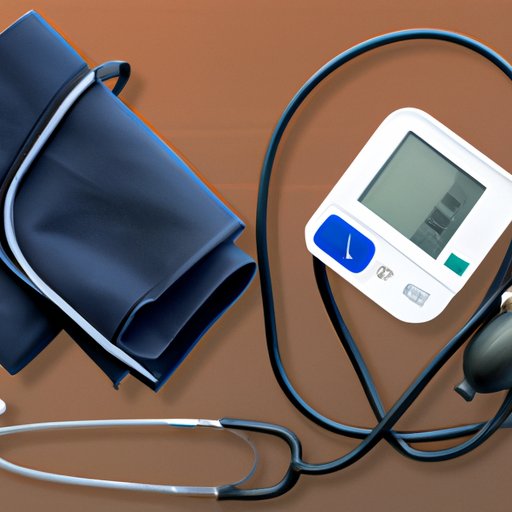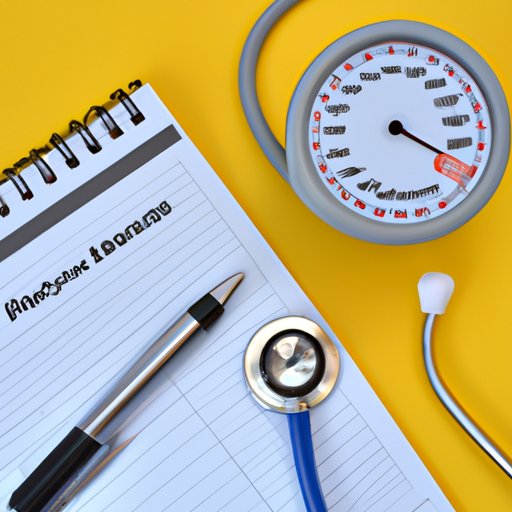Introduction
High blood pressure, also known as hypertension, is a common health concern that affects millions of people around the world. If not managed properly, it can lead to serious health complications such as heart disease, stroke, and kidney failure. Fortunately, there are many approaches that can help lower blood pressure and reduce the risk of these complications. The following article will cover some of the most effective ways to lower blood pressure naturally, including lifestyle changes, dietary recommendations, holistic techniques, medication, and tracking progress.
7 Simple Lifestyle Changes to Lower Your Blood Pressure Today
Lifestyle changes are important for managing blood pressure. Here are seven specific changes that you can make right away to help lower your blood pressure:
- Reduce salt intake: Aim for less than 2,300 milligrams of sodium per day.
- Increase physical activity: Try to get at least 30 minutes of moderate exercise most days of the week.
- Lose weight: If you are overweight, losing even a few pounds can help lower your blood pressure.
- Eat a healthy diet: Focus on eating fruits, vegetables, whole grains, lean proteins, and low-fat dairy.
- Quit smoking: Smoking can raise blood pressure, so quitting can help lower it.
- Limit alcohol: Too much alcohol can raise blood pressure, so keep it in moderation.
- Manage stress: Stress can contribute to high blood pressure, so try to find healthy ways to manage it, such as exercise, meditation, or spending time with loved ones.
Remember, it’s important to speak with your healthcare provider before making any major lifestyle changes.
The Best Foods for Lowering Blood Pressure
Your diet plays a crucial role in managing blood pressure. Here are some specific foods that have been shown to have blood-pressure-lowering properties:
- Leafy greens: such as kale, spinach, and collard greens
- Berries: such as blueberries, strawberries, and raspberries
- Garlic: fresh, cooked or powdered
- Dark chocolate: look for 70% or higher cocoa content
- Whole grains: such as brown rice, quinoa, and oats
- Fatty fish: such as salmon and tuna
- Low-fat dairy: such as milk, yogurt, and cheese
Here are some ideas for incorporating these foods into your diet:
- Eat a salad with leafy greens for lunch or dinner
- Add berries to your breakfast cereal or oatmeal
- Roast garlic and add it to your favorite dishes
- Enjoy a small piece of dark chocolate as a treat
- Replace refined grains with whole grains in your meals
- Eat fatty fish twice a week
- Use low-fat dairy products in your cooking and baking

Taking a Holistic Approach to Blood Pressure Management
Holistic health practices can be beneficial for managing blood pressure. Here are some alternative techniques that can help lower blood pressure:
- Acupuncture: can help relieve stress and improve blood circulation
- Meditation: can help reduce stress and improve overall well-being
- Yoga: can improve flexibility, strength, and relaxation
- Massage: can help lower blood pressure and reduce stress and anxiety
Here are some tips for incorporating these techniques into your routine:
- Try acupuncture at a local clinic or make an appointment with a certified acupuncturist
- Join a meditation class or download a meditation app to guide you
- Join a yoga class at your local gym or community center or follow along with an online video
- Book a massage appointment with a licensed massage therapist
The Connection Between Stress and High Blood Pressure
Stress is a known contributor to high blood pressure. Here are some stress-reduction techniques that can help lower blood pressure:
- Deep breathing exercises: can help slow down breathing and promote relaxation
- Mindfulness practices: can help reduce stress and promote mental clarity
- Regular relaxation time: taking time for yourself can help you unwind and de-stress
Here are some tips for incorporating these techniques into your routine:
- Take deep breaths for 5-10 minutes each day
- Try a mindfulness app or attend a mindfulness workshop
- Schedule regular relaxation time into your daily routine
Understanding the Role of Medication in Blood Pressure Management
There are several types of blood pressure medications available that can be effective in managing blood pressure. Some of the most common medications include:
- ACE inhibitors: work by relaxing blood vessels
- Beta blockers: work by lowering heart rate and blood pressure
- Diuretics: work by promoting urine output to reduce excess fluid in the body
It’s important to work with your healthcare provider to determine the best medication and dosage for you. Be aware that some medications may have side effects or interact with other medications you are taking.
Tracking Your Progress: Tools for Monitoring Blood Pressure
Tracking your blood pressure is an important part of managing hypertension. There are several apps and devices that can help you monitor your blood pressure levels over time:
- Omron Evolv Wireless Upper Arm Blood Pressure Monitor
- iHealth Wireless Blood Pressure Monitor
- Withings Wireless Blood Pressure Monitor
- QardioArm Wireless Blood Pressure Monitor
Here are some tips for incorporating regular monitoring into your routine:
- Choose an app or device that is easy to use and compatible with your smartphone
- Track your blood pressure at least once a week and keep a record
- Share your results with your healthcare provider during routine visits
Conclusion
Lowering blood pressure is an essential part of maintaining good health and preventing serious health complications. By incorporating the lifestyle changes, dietary recommendations, holistic techniques, medication, and tracking methods outlined in this article, you can take important steps towards lowering your blood pressure naturally. Remember to speak with your healthcare provider before making any major changes to your routine, and always prioritize your health and wellness!
Resources:
- American Heart Association: https://www.heart.org/en/health-topics/high-blood-pressure
- National Institutes of Health: https://www.nhlbi.nih.gov/health-topics/high-blood-pressure
- Mayo Clinic: https://www.mayoclinic.
